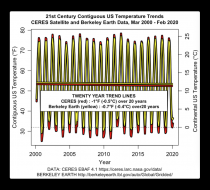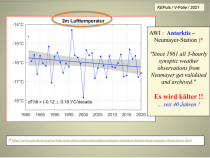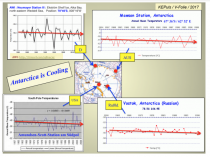For decades there has been intermittent attention paid to the claim that the Urban Heat Island creates a warming trend as formerly rural spots are paved over, trapping heat, which then boosts the warming that inevitably gets blamed on greenhouse gases. Including in the claims we discussed last week that the U.S. just had its hottest summer ever. A particular indicator that the UHI is behind claims of unprecedented heat is if nighttime lows are rising faster than daytime highs, incidentally decreasing rather than increasing the swing in temperature, which is very much what you’d expect if human structures including roads were trapping the sun’s heat during the day then releasing it at night.
A July news story out of San Diego noted this effect, saying “Last month was the hottest June ever recorded in North America, but climate scientists say the most dramatic temperature trend isn’t happening during the day; It’s happening at night. June saw three times as many nighttime records as any June on record, according to data from the National Oceanic and Atmospheric Administration.” And NOAA said, of August at least, that “Much of the above-average warmth can be attributed to warm overnight temperatures.” But what they didn’t point out is that’s evidence of data contamination not climate change.
Another indication that the Urban Heat Island is creating the illusion of unprecedented warming is that the US Climate Reference Network (USCRN), a network of U.S. stations specifically created to exclude measuring points vulnerable to UHI, shows no warming from 2005-2019. In which case we’re not seeing the fever peaking and killing the patient. A classic effort to debunk this finding not only used the adjusted NOAA/NASA data, but said “Even if the US experienced a flat temperature change for 14 years, this would not prove that global warming isn’t occurring. The US only covers a small portion of the planet, and a 14-year period is too short to reliably indicate long-term trends over short-term variability.” But that never stopped them from pointing to US heat records, when they happen, as proof of impending global destruction. And the dodge raises the ever-pertinent question: If this evidence does not persuade you that the theory is open to debate, what if anything might do so? The fact that Scandinavia seems to show no warming in July in the 21st century? Or that USCRN showed this February the coldest in the US in 30 years? But cold is just weather.
Or is it? Back in April Willis Eschenbach did some work on data from Berkeley Earth and CERES satellites and found that the contiguous U.S. showed a cooling trend from March 2000 through February 2020. And then he made a very relevant point about the scale of the change: “Now, before anyone starts yelling ‘But that’s just the contiguous US, not the globe!’, yes, I know that. I’m just saying that if you think the US temperature has gone up over the 21st century, you’re wrong. The US has cooled over that time. And this reveals a deep truth, which is that if it were not for accurate thermometers, hundreds and hundreds of US surface temperature station sites, and satellites, we’d never know if the US had warmed or cooled over the last two decades… the changes are far too small and too widespread for our human senses to register.”
This observation recalls a remark we quoted in our 2020 “Catastrophe Question” video from Swedish climatologist Lennart Bengtsson, who observed a few years ago that “The warming we have had over the last 100 years is so small that if we didn’t have meteorologists and climatologists to measure it we wouldn’t have noticed it at all.” And Judith Curry recently made a very pertinent observation on this score, quoting a story from Yahoo! News that “Parts of the US are getting dangerously hot. Yet Americans are moving the wrong way” then adding “Hmmm… somebody’s drawing the wrong conclusions?”
The general IPCC line is that temperatures have gone up 1.07C since pre-industrial times, and if they rise by more than another 0.43C, the Paris target, we’re all going to be in trouble. Not that we already are, as newspapers claim. That we will be. But frankly less than half a degree C, three-quarters of a degree F, is nothing. Nothing you could notice, nothing your crops could notice, nothing the planet could notice. And nothing we could measure. (Oddly the latest IPCC report claims a total of 1.07C from 1850-1900 to 2010-2019 on p. 38 of the Summary for Policymakers, after on p. 6 calling it the best estimate of “total human-caused global surface temperature increase from 1850-1900 to 2010-2019” so they don’t seem very clear on whether there has been any net natural warming at all since the Crimean War.)
Despite even the IPCC’s caution about extreme weather, NBC roars ahead: “Global warming is making heat waves and other extreme weather events both more likely and more severe, and climate scientists have said conditions this summer offer a glimpse of what could become more common in the future.” But there’s a big difference between becoming more common in the future and having become more common in the present. And as we have pointed out before, NBC’s main science reporter has an MA in Journalism and a BA in Criminology. Who these “climate scientists” are and what they said and why is not included in her stories as news with specific citations. It is just ominous background music.
See the Climate Reference Network plot of Monthly Average US temperatures since inception in 2005 and the constructed data from the US climate divisions back to 1998’s super El Nino.
And the average monthly maximum temperatures for the US climate divisions.
---------
Addendum from Joseph D’Aleo
The warming as many have show in mostly in the elevated nighttime lows in urban areas ad airports which hold their heat. Record highs have not been increasing despite the best efforts of the zealot Tom Peterson who left NCDC to help lead the WMO team on trying to find evidence of increasing record heat. In Antarctica they found a station on the tip of the Antarctic Peninsular (an active volcanic region surface and deep sea) and subject to the foehn wind when the wind blows downslope. But the peninsular is not warming nor the ice diminishing. In fact the South pole had its coldest winter on record back to 1957 (see here). See images from Klaus-Eckhart Puls (prominent German met, who runs “EIKE” (European Info Center for Climate & Economics) - HT Hans










